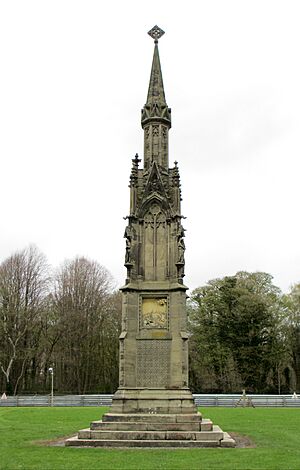Monument to Captain John Francis Egerton facts for kids
The Monument to Captain John Francis Egerton is a special memorial located on the Oulton Estate in Little Budworth, Cheshire, England. It was built to remember Captain John Francis Egerton, who sadly died in 1846. He was injured during a big conflict called the First Anglo-Sikh War. This monument was designed by famous architects named Scott and Moffatt. It is considered a very important historical building, listed as Grade II* on the National Heritage List for England.
Contents
History of the Monument
John Francis Egerton was born in 1810 and passed away in 1846. He was the younger brother of Sir Philip Grey Egerton, who owned the Oulton Estate. John was a Captain in the Bengal Artillery, which was part of the British army in India.
The Battle and Injury
In December 1845, Captain Egerton fought in the Battle of Ferozeshah during the First Anglo-Sikh War. This was a tough battle, but the Sikh forces were eventually defeated. After the fighting, Captain Egerton was exploring the battleground. Sadly, he was attacked by two Sikh soldiers hiding in a village. He was badly injured and died from his wounds on January 23, 1846. He was buried in a place called Ferozepore.
Building the Memorial
After Captain Egerton's death, people wanted to create a memorial for him. In May 1846, a meeting was held. Sir Philip, John's brother, suggested two ideas: a stained glass window in a church or a monument on the Oulton Estate. The group chose to build a monument on the estate. They hired Scott and Moffatt to design it. The person who carved the statues on the monument is not known.
What the Monument Looks Like
The monument is built in a style called Gothic, which was popular in medieval times. It looks like an Eleanor cross, a type of cross often built in England during the Middle Ages.
Design and Materials
The monument is made from yellow sandstone. It stands about 9.6 meters (31.5 feet) tall, on top of steps that are about 0.8 meters (2.6 feet) high. The cross sits on five square steps. It has a square base with two parts, an eight-sided tower (called an octagonal turret), and an eight-sided pointed top (called an octagonal spire) with a cross on top.
Details and Carvings
The lower part of the base is quite plain. It has diagonal supports called buttresses. On the south side, there are carved patterns and a panel with a picture. This carving is old and hard to see, but it seems to show a house and classical figures. The sides of the monument have blank panels. On the north side, there is a bronze plaque with an inscription.
The upper part of the base is narrower and also has diagonal buttresses. These buttresses have small sheltered spaces called canopied niches. Inside these niches are statues of female figures dressed in medieval clothes. Above these, the buttresses rise into pointed decorations called crocketed pinnacles, which have decorative gargoyles. The spaces between them have decorative stone patterns called tracery and pointed tops called gables.
The eight-sided turret is decorated with more blank tracery. At its top, there is a decorative ledge called a cornice with gables. The spire sits on top of the turret.
The Bronze Plaque
The bronze plaque on the north side tells Captain Egerton's story. It says he was born on August 10, 1810, and died on January 23, 1846. It explains that he was a Captain in the Bengal Artillery and was present at the Battle of Ferozeshah. It describes how he was injured by two Sikhs while exploring the captured ground. He suffered for a month before he died. The plaque also mentions that he was promoted to Major in England after his death, but he was already gone. Viscount Hardinge, a high-ranking official, described Captain Egerton as one of the best young officers in the Indian Army. The cross was built by people from Cheshire to remember him and show sympathy to his family.
Why This Monument is Important
The monument was officially recognized as a Grade II* listed building on March 12, 1986. This means it is a "particularly important building of more than special interest." It's considered one of the most detailed Victorian monuments inspired by the Eleanor Crosses.


